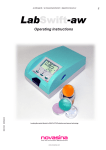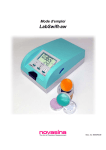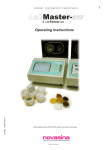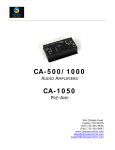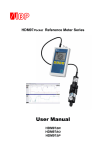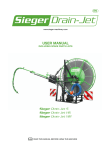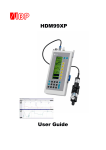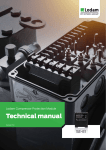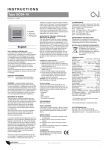Download User manual
Transcript
< 1% % !" " # $%& 33*4) 5 6 4 ' !" 76 4 % * -- + " ' ()* !' ++' ,,,.%/ -0 76 4 #!76 8( ! 96 3( ! (*: %;! 1% .%/ 2.%/ -0 (5 % ;= 6 = %; > = $ = ? 1% . % $% =% ; ; %% 1; = @; % % 1 11 1 % & 1 11 =A =% % % =A =% % % 1 % @& =A =% % % 1 % .%>@ & =A =% % % 1 % @& % 1 =A =% % % 1 % @ & % 1 @ BB =A =% % % 1 % @ & % 1 @ BB ( 11 =% . = ; C * ! " #$ ! %&'( ) ( * 8( =% % ;( ; 1 > + + ,% - ) . + + ,% - ) . + + ,% ) . + + ,% ) . + + ,% ) . + + ,% ) . + + ,% ) . + + ,% ) . + +0, +-1 ( + + , 2 3+4 ( 1.% >6 ; 1% !" " # $%& 33*4) 5 6 4 ' !" 76 4 #! / / / / / / / / " ' ()* !' ++' ,,,.%/ -0 76 4 #!76 8( ! 96 3( ! (*: + %;! 0 1% .%/ 2.%/ -0 (5 A =% > 1D6 4 A. ..>% = = 1% % . =A =% % % % A D6 4E ,% 7 % & 7 7A> % = % ; 1 F A > 1= ;% D6 4 7 1 % &% =% -A % ,A=A1 % ,% = =% 1 % -A 1 % &= = A ., A A. % = > 1- A .. =% % ; , A D6 4 % A 1 % & !" " # $%& 33*4) 5 6 4 ' !" 76 4 " ' ()* !' ++' ,,,.%/ -0 76 4 #!76 8( ! 96 3( ! (*: %;! 1% .%/ 2.%/ -0 (5 For your safety The WIO400 (WIO) is designed as water in oil monitoring system, with a relay switchoff function and RS485 communication based on Modbus protocol. Before use please read the user manual and carefully store it in a safe place. Install and operate the device only after reading and comprehending the instruction manual, and after you are familiar with the valid rules on work safety and accident prevention. Please use the device only as specified. For this purpose please also note the values in section “Technical data”. During transport, storage and operation please adhere to the conditions listed in “Technical data”. IMPORTANT Only qualified personnel may assemble start-up and maintain the unit when it is in a zero voltage state. Only qualified electricians may work on electrical installations. The connection and instruction manual contains information that enables the proper and efficient use of the WIO monitoring system. PAJ Sensors A/S is not liable for damage caused be improper use of this device. This manual is an integral part of the basic knowledge necessary for proper use of the system. Rights PAJ Sensors A/S reserves the right to alter its products without prior notice. Copying and using the instruction manual for other purposes is only allowed with the acceptance from PAJ Sensors A/S. PAJ Sensors A/S accepts no responsibility for possible errors and deficiencies in brochures, catalogues and other printed material. PAJ Sensors A/S guarantees correct function as well as fulfillment of the safety requirements only when connections are made in accordance with instructions. Safety observations The comments about safety in this document will not discuss safety observations of individual machine parts where safety devices (usually safety relays) are applied. Here the respective instruction manuals will be referenced! This document merely describes how to establish a WIO and how to start it up. !" " # $%& 33*4) 5 6 4 ' !" 76 4 " ' ()* !' ++' ,,,.%/ -0 76 4 #!76 8( ! 96 3( ! (*: %;! 1% .%/ 2.%/ -0 (5 WARNING The monitoring system during machine operation cannot be guaranteed if the system is connected incorrectly or not used as specified. This may lead to fatal injuries. Interventions and changes to the WIO monitoring system are not permitted, unless they are explicitly described in this user manual or be written from PAJ Sensors A/S. The regional legal regulations and conditions of the liability insurance of the employer must be maintained. Area of application The WIO monitoring system is usually used in engines were a WIO will monitor the water content in lubrication oil, gear box oil, diesel oil, hydraulic oil or transformer oil. The advantage of this monitoring system is the simple 4-20 mA interface and the two relays indicating alarms, with digital readout. Normally the WIO sensor is calibrated in Taro30 lubrication oil, if nothing else are defined from customer. Short description of the function PAJ Sensors A/S has developed a water in oil (WIO) monitoring system. The fundamental idea of the WIO system is to easily and continuously monitor the water activity (aw) in oil. The output is converted into a standard 4-20 mA output. The system also includes two relays indicating when too much water is present in the oil. Default alarm values are set to 0,5 aw (high alarm) and 0,9 aw (high high alarm) With the WIO-Software can HHA and HA level changes and there can be continuously read out the actual (aw) or PPM of water in the oil. WARNING Do not use the sensor or relays to automatically enable/turn on or disable/shut down engine. The decision to enable/turn on or disable/shut down an engine, based on the sensor data, must be taken by proper trained crew personnel, not by the sensor system. !" " # $%& 33*4) 5 6 4 ' !" 76 4 " ' ()* !' ++' ,,,.%/ -0 76 4 #!76 8( ! 96 3( ! (*: ! %;! 1% .%/ 2.%/ -0 (5 Water activity (aw) provides the relative availability of water in oil where pure oil has an activity of zero and oil saturated with distilled water has an activity of exactly one. Under normal operation the WIO400 continuously supplies an output analogue signal of 4 to 20 mA corresponding to 0.01 to 1.00 aw. Alarm indications with 0.03 aw hysteresis via 2 relays are provided for each sensor. These data can also be read out from the sensor on the RS485 Modbus communication line. Default alarm values are 0,5 aw and 0,9 aw. Assumes these alarm values: High alarm on at 0,50 aw (12 mA). High alarm off at 0,47 aw (11,5 mA) High high alarm on at 0,90 aw (18,4 mA). High high alarm off at 0,87 aw (17,9 mA). High high alarm will disable high alarm, thus only one alarm can be active. Internal function failure will be indicated by activating both alarm relays at the same time, or indicated as defined in the NAMUR NE43. Internal failures includes: • • • Sensor reading out of range. Sensor reading CRC error. Unstable Sensor reading. NAMUR NE43 is a German fault detection standard for 4-20mA analogue signals. It allows the user to know if there is a fault within the instrument, by sending analogue signal below 4mA and/or above 20mA. In accordance with NAMUR NE43, the failure is indicated by: • Fault indicated by analogue output =<2,0 mA !" " # $%& 33*4) 5 6 4 ' !" 76 4 " ' ()* !' ++' ,,,.%/ -0 76 4 #!76 8( ! 96 3( ! (*: %;! 1% .%/ 2.%/ -0 (5 On the WIO Sensor there is a button for testing the alarm functions. By pushing the Test button for 5 sec the high alarm relay turns on, and by pushing the Test button for 10 sec the high high alarm also turns on, after pushing the Test button for 15 sec both relays turns off. off After 20 sec pushing ng the Test button then the Test button will be ignored by the soft ware. ware Test Button Un-pressed Pressed = 5 sec Mode Normal operation and no alarm Test of high alarm Pressed = 10 sec Test of high high alarm Pressed = 15 sec Test of high alarm and high high alarm Pressed = 20 sec Normal operation Test Button Un-pressed Pressed = 5 sec Mode Normal operation and with high alarm active Test of high alarm Pressed = 10 sec Test of high high alarm Pressed = 15 sec Test of high alarm and high high alarm Pressed = 20 sec Normal operation !" " # $%& 33*4) 5 6 4 ' !" 76 4 Output Relay Relay 1 closed Relay 2 closed Relay 1 open Relay 2 closed Relay 1 closed Relay 2 open Relay 1 closed Relay 2 closed Normal Analogue Output Normal Output Relay Relay 1 open Relay 2 closed Relay 1 open Relay 2 closed Relay 1 closed Relay 2 open Relay 1 closed Relay 2 closed Normal Analogue Output Normal " ' ()* !' ++' ,,,.%/ -0 76 4 #!76 8( ! 96 3( ! (*: " %;! Normal Normal Normal Normal Normal Normal Normal Normal 1% .%/ 2.%/ -0 (5 IMPORTANT Only qualified personnel may assemble and maintain the unit. Only qualified personnel may install the unit. Screw in probe with ISO 228-1 228 G ¾” thread pressure-tight tight directly in the center of the oil pipe where the measurement is to take place. The threads should be sealed with Loctite® 271. The sensor should sh be mounted with max. torque of 35 Nm. Connect the cables from the WIO sensor to the Terminal box. Use a hexagon wrench size 30. !" " # $%& 33*4) 5 6 4 ' !" 76 4 " ' ()* !' ++' ,,,.%/ -0 76 4 #!76 8( ! 96 3( ! (*: # %;! 1% .%/ 2.%/ -0 (5 3, % % 1 IMPORTANT Only qualified personnel may assemble start-up and maintain the terminal box(s) when it is in a zero voltage state. Only qualified electricians may work on electrical installations. Install +24 VDC and GND into the terminal box and connect the 4-20 mA to an external device if needed. Connect the relay to external device if needed. If the terminal box has a (aw) or PPM display, there must be a short circuit between terminals 11 and 12. This short circuit produces the needed closed loop for mA measurement. If the terminal box has a °C or °F display, there must be a short circuit between terminals 9 and 10. This short circuit produces the needed closed loop for mA measurement. After installing the WIO-Software can PC and terminal box be connected through DB9 connector. Last connect the cables from the Terminal box to the sensor. It is allowed (but not necessary) to connect screw terminal 10 and 12 “- 4-20 mA” to screw terminal 14 “GND”, thus creating common ground for the output and the power. Terminal boxes with display. Screw terminal pin 11 and 12 or screw terminal pin 9 and 10 can be connected to external equipment, but only in a closed loop for mA measurement. !" " # $%& 33*4) 5 6 4 ' !" 76 4 " ' ()* !' ++' ,,,.%/ -0 76 4 #!76 8( ! 96 3( ! (*: ' %;! 1% .%/ 2.%/ -0 (5 !" " A # > = = (? ; ;A 1 % &= %= - Contact-Number Description 9 +4 – 20 mA positive analog output signal for indication of temperature in oil. This option is not available for WIO200 10 -4 – 20 mA return analog signal for indication of temperature in oil. This option is not available for WIO200 11 +4 – 20 mA positive analog output signal for indication of aw or PPM in oil. 12 -4 – 20 mA return analog signal for indication of aw or PPM in oil. 13 Power supply, 24VDC ±10% and with max. residual voltage ripple 10% 14 Power supply ground terminal contact 15 Relay contact for HH Alarm 16 Relay contact for HH Alarm 17 Relay contact for H Alarm 18 Relay contact for H Alarm $ = = .. .. .. 1 & & + & A% !" " # $%& 33*4) 5 6 4 ' 1 % !" 76 4 &. % ; " ' ()* !' ++' ,,,.%/ -0 76 4 #!76 8( ! 96 3( ! (*: %;! 1% .%/ 2.%/ -0 (5 # ( 11 $ % =% 3, % % 1 DB9 connector pin layout Illustration !" " # $%& 33*4) 5 6 4 ' !" 76 4 Assignment " ' ()* !' ++' ,,,.%/ -0 76 4 #!76 8( ! 96 3( ! (*: %;! 1% .%/ 2.%/ -0 (5 Sensor dimensions in mm for WIO standard 1 G ¾” Thread ISO 228-1 30mm Wrench max. torque 35 Nm Sensor dimensions in mm for WIO Ball valve !" " # $%& 33*4) 5 6 4 ' !" 76 4 " ' ()* !' ++' ,,,.%/ -0 76 4 #!76 8( ! 96 3( ! (*: + %;! 1% .%/ 2.%/ -0 (5 ! !" " # $%& 33*4) 5 6 4 ' !" 76 4 " ' ()* !' ++' ,,,.%/ -0 76 4 #!76 8( ! 96 3( ! (*: %;! 1% .%/ 2.%/ -0 (5 & $ WIO Standard WIO Ball Valve Output Analogue output (galvanic isolated) 4 – 20 mA for %, Analogue output (galvanic isolated) 4 – 20 mA for temperature (0°C – 100°C) Max. Load (analogue output) < 500 Measurement Range (4 – 20 mA) 0,01 – 1,00 %, Accuracy (0,05-0,95 %,) ± 0,03 %, Accuracy (outside 0,05-0,95 %,) ± 0,05 %, Resolution < 0,004 %, Digital output Communication RS485 Input Supply nominal voltage 24V DC ± 10% Max. residual voltage ripple 10% Maximum Load current 58 mA + output load current Max. Power input < 2,4 VA Relays Contact arrangement 2 x Normally Closed (NC) Rated voltage 60V Rated current (40°C) 1A Max. DC Load breaking capacity !" " # $%& 33*4) 5 6 4 ' !" 76 4 " ' ()* !' ++' ,,,.%/ -0 76 4 #!76 8( ! 96 3( ! (*: %;! 1% .%/ 2.%/ -0 (5 Relay 1 „High Alarm“ Relay 2 „High High Alarm“ Default High Alarm 0,50 %, Default High High Alarm 0,90 %, Socket specification Connector design 1x male socket, 1x female socket Connector locking system Screw-locking Wire gauge 0,25 mm Contacts 8 Pol Rated voltage 60V Rated current (40°C) 1A 2 Cable specification Cable design Multipair overall screened cable PG9 Outlet diameter 9,9 mm Voltage class 0,6/1kV Wires 4x2 twisted pair Wire gauge 0,75 mm 2 ' 5 =% % Max. Oil temperature 90°C Max. Oil pressure 10 Bar 8 @? ! Response times Delay before valid data from start-up < 30 s Delay before valid data from installation (first use) 10 minutes Device Failure Indication Analogue output < 2 mA Manual test Press sensor button for 5 seconds High Alarm turns on for 5 seconds Press sensor button for 10 seconds High High Alarm turns also on for 5 seconds Press sensor button for 15 seconds Both Alarms turns off Press sensor button for 20 seconds Normal operating and test button ignored Miscellaneous Ambient Temperature, running / storage 0 - 90°C / -30 - +95°C Relative humidity for running and storage 10% up to 95%, no condensation Re calibration Recommended with max 3 years interval !" " # $%& 33*4) 5 6 4 ' !" 76 4 " ' ()* !' ++' ,,,.%/ -0 76 4 #!76 8( ! 96 3( ! (*: ! %;! 1% .%/ 2.%/ -0 (5 Warranty 2 years Approvals Germanischer Loyd Enclosure Weight for WIO standard 640 grams Weight for WIO Ball valve 690 grams Connection (mechanical) ISO 228-1 G ¾ male and female thread. Enclosure material Stainless Steel Protective type IP66 !" " # $%& 33*4) 5 6 4 ' !" 76 4 " ' ()* !' ++' ,,,.%/ -0 76 4 #!76 8( ! 96 3( ! (*: %;! 1% .%/ 2.%/ -0 (5 & $ ! Output Analogue output See the specifications for sensor’s analogue output Digital output See the specifications for sensor’s digital output Input Supply nominal voltage 24V DC ± 10% Max. residual voltage ripple 10% Maximum Load current 20 mA + output load current Max. Power input < 0,6 VA Relays Contact arrangement 2 x Normally Closed (NC) Rated voltage 250 VAC Max. switching voltage 400VAC Rated current 2A Breaking capacity max. 1250VA Enclosure Weight 510 grams Connection to sensor (mechanical) 2 x PG9 connectors (male + female) or gland PG * Connection (mechanical) 2 x gland PG ** Enclosure material Aluminum Protective type IP66 Warranty 2 years G GG ; ; % % B E 3 '73 B E 3 '73 3 73 7 !F 7 ! 3 F FUNCTIONING Terminal box shall be provided with 24vdc. Terminal box supply 24vdc on to WIO sensor. WIO sensor delivers mA, digital values and relay status to the terminal box. !" " # $%& 33*4) 5 6 4 ' !" 76 4 " ' ()* !' ++' ,,,.%/ -0 76 4 #!76 8( ! 96 3( ! (*: "%;! 1% .%/ 2.%/ -0 (5 & $ $ ! Output Analogue output See the specifications for sensor’s analogue output Digital output See the specifications for sensor’s digital output Input Supply nominal voltage 24V DC ± 10% Max. residual voltage ripple 10% Maximum Load current 45 mA + output load current Max. Power input < 1,3 VA Relays Contact arrangement 2 x Normally Closed (NC) Rated voltage 250 VAC Max. switching voltage 400VAC Rated current 2A Breaking capacity max. 1250VA Display version - ( ),% %= >; 1 7 7 * Accuracy (0,05-0,95 %,) ± 0,03 %, Resolution <0,004 %, Display version - ' )+, * Accuracy (0,05-0,95 %,) 30% Resolution 1 PPM Enclosure Weight 570 grams Connection to sensor (mechanical) 2 x PG9 connectors (male + female) or gland PG * Connection (mechanical) 2 x gland PG ** Enclosure material Aluminum Protective type IP66 Warranty 2 years G GG ; ; % % B E 3 '73 B E 3 '73 !" " # $%& 33*4) 5 6 4 ' 3 73 !" 76 4 7 !F 7 ! 3 F " ' ()* !' ++' ,,,.%/ -0 76 4 #!76 8( ! 96 3( ! (*: #%;! 1% .%/ 2.%/ -0 (5 FUNCTIONING Terminal box shall be provided with 24vdc. Terminal box supply 24vdc on to WIO sensor. Terminal box measuring mA from the sensor, and convert it to %, or PPM value. WIO sensor delivers mA, digital value and relay status to the terminal box. IMPORTANT The display is an indication of the water level in the oil. Display can be shipped as PPM or aw. Upon ordering a PPM display the customer must specify the water saturation point in PPM of the used oil at the preferred working temperature of the oil. The saturation point is typically between 3000-10000 PPM. Alternatively the customer can ship 10 liters of oil to PAJ Sensor A/S for inspection including specification of the working oil temperature. WARNING All displays will show from positive values when operating properly. There will appear a negative value during start-up, after 5 seconds the value will be in positive measurement range. Otherwise, if a negative value is present the Terminal box might have been installed incorrectly. NOTE There are three terms for the measurement of water in oil. PPM is where the saturation point must be known at a given temperature. %H20 and aw measures in principle the same, aw measures from 0,03 up to 1,00 moisture in the oil, and %H20 measures from 0,00 up to 1,00 moisture in the oil. !" " # $%& 33*4) 5 6 4 ' !" 76 4 " ' ()* !' ++' ,,,.%/ -0 76 4 #!76 8( ! 96 3( ! (*: '%;! 1% .%/ 2.%/ -0 (5 & $ ! Output Analogue output See the specifications for sensor’s analogue output Digital output See the specifications for sensor’s digital output Input Supply nominal voltage 24V DC ± 10% Max. residual voltage ripple 10% Maximum Load current 33 mA + output load current Max. Power input < 1,0 VA Relays Contact arrangement 2 x Normally Closed (NC) Rated voltage 250 VAC Max. switching voltage 400VAC Rated current 2A Breaking capacity max. 1250VA Buzzer Oscillation frequency 3000±500 Hz Sound pressure level 85db by open housing Tone pulsed Button with LED Blink frequency 2 Hz Color RED Enclosure Weight 530 grams Connection to sensor (mechanical) 2 x PG9 connectors (male + female) or gland PG * Connection (mechanical) 2 x gland PG ** Enclosure material Aluminum Protective type IP66 Warranty 2 years G GG ; ; % % B E 3 '73 B E 3 '73 !" " # $%& 33*4) 5 6 4 ' 3 73 !" 76 4 7 !F 7 ! 3 F " ' ()* !' ++' ,,,.%/ -0 76 4 #!76 8( ! 96 3( ! (*: + %;! 1% .%/ 2.%/ -0 (5 FUNCTIONING Terminal box shall be provided with 24vdc. Terminal box supply 24vdc on to WIO sensor. Terminal box indicate the relay status from the WIO sensor. WIO sensor delivers mA, digtal values and relay status to the terminal box. H-Alarm LED is for indication of the High Alarm relay state from the WIO sensor. When the alarm condition is generated by the WIO sensor, then the High Alarm relay is open and the H-Alarm LED flash red ON/OFF sequence to show the High Alarm state, and the alarm signal buzzer will be switched ON. HH-Alarm LED is for indication of the High High Alarm relay state from the WIO sensor. When the alarm condition is generated by the WIO sensor, then the High High Alarm relay is open and the HH-Alarm LED flash red ON/OFF sequence to show the High High Alarm state, and the alarm signal buzzer will be switched ON. The H-Alarm LED or HH-Alarm LED will stay in blinking mode until the H-Alarm or HH-Alarm button is pressed, then the LED constantly turned on. The alarm signal buzzer will stay on until the H-Alarm or HH-Alarm button is pressed. Abstract representation of the H-Alarm and HH-Alarm button and LED function: Figure 1: H-Alarm and HH-Alarm button function !" " # $%& 33*4) 5 6 4 ' !" 76 4 " ' ()* !' ++' ,,,.%/ -0 76 4 #!76 8( ! 96 3( ! (*: + %;! 1% .%/ 2.%/ -0 (5 & $ ! -- Output Analogue output See the specifications for sensor’s analogue output Digital output See the specifications for sensor’s digital output Input Supply nominal voltage 24V DC ± 10% Max. residual voltage ripple 10% Maximum Load current 58 mA + output load current Max. Power input < 1,7 VA Relays Contact arrangement 2 x Normally Closed (NC) Rated voltage 250 VAC Max. switching voltage 400VAC Rated current 2A Breaking capacity max. 1250VA Display version - ( ),% %= >; 1 7 7 * Accuracy (0,05-0,95 %,) ± 0,03 %, Resolution <0,004 %, Display version - ' )+, * Accuracy (0,05-0,95 %,) 30% Resolution 1 PPM Buzzer Oscillation frequency 3000±500 Hz Sound pressure level 85db by open housing Tone pulsed Button with LED Blink frequency 2 Hz Color RED !" " # $%& 33*4) 5 6 4 ' !" 76 4 " ' ()* !' ++' ,,,.%/ -0 76 4 #!76 8( ! 96 3( ! (*: ++%;! 1% .%/ 2.%/ -0 (5 Enclosure Weight 650 grams Connection to sensor (mechanical) 2 x PG9 connectors (male + female) or gland PG * Connection (mechanical) 2 x gland PG ** Enclosure material Aluminum Protective type IP66 Warranty 2 years G GG ; ; % % B E 3 '73 B E 3 '73 3 73 7 !F 7 ! 3 F FUNCTIONING Terminal box shall be provided with 24vdc. Terminal box supply 24vdc on to WIO sensor. Terminal box measuring mA from the sensor, and convert it to %, or PPM value. WIO sensor delivers mA, digital values and relay status to the terminal box. H-Alarm LED is for indication of the High Alarm relay state from the WIO sensor. When the alarm condition is generated by the WIO sensor, then the High Alarm relay is open and the H-Alarm LED flash red ON/OFF sequence to show the High Alarm state, and the alarm signal buzzer will be switched ON. HH-Alarm LED is for indication of the High High Alarm relay state from the WIO sensor. When the alarm condition is generated by the WIO sensor, then the High High Alarm relay is open and the HH-Alarm LED flash red ON/OFF sequence to show the High High Alarm state, and the alarm signal buzzer will be switched ON. The H-Alarm LED or HH-Alarm LED will stay in blinking mode until the H-Alarm or HH-Alarm button is pressed, then the LED constantly turned on. The alarm signal buzzer will stay on until the H-Alarm or HH-Alarm button is pressed. Abstract representation of the H-Alarm and HH-Alarm button and LED function: !" " # $%& 33*4) 5 6 4 ' !" 76 4 " ' ()* !' ++' ,,,.%/ -0 76 4 #!76 8( ! 96 3( ! (*: + %;! 1% .%/ 2.%/ -0 (5 Figure 2: H-Alarm and HH-Alarm button function IMPORTANT The display is an indication of the water level in the oil. Display can be shipped as PPM or aw. Upon ordering a PPM display the customer must specify the water saturation point in PPM of the used oil at the preferred working temperature of the oil. The saturation point is typically between 3000-10000 PPM. Alternatively the customer can ship 10 liters of oil to PAJ Sensor A/S for inspection including specification of the working oil temperature. WARNING All displays will show from positive values when operating properly. There will appear a negative value during start-up, after 5 seconds the value will be in positive measurement range. Otherwise, if a negative value is present the Terminal box might have been installed incorrectly. NOTE There are three terms for the measurement of water in oil. !" " # $%& 33*4) 5 6 4 ' !" 76 4 " ' ()* !' ++' ,,,.%/ -0 76 4 #!76 8( ! 96 3( ! (*: + %;! 1% .%/ 2.%/ -0 (5 PPM is where the saturation point must be known at a given temperature. %H20 and aw measures in principle the same, aw measures from 0,03 up to 1,00 moisture in the oil, and %H20 measures from 0,00 up to 1,00 moisture in the oil. !" " # $%& 33*4) 5 6 4 ' !" 76 4 " ' ()* !' ++' ,,,.%/ -0 76 4 #!76 8( ! 96 3( ! (*: +! %;! 1% .%/ 2.%/ -0 (5 Output Analogue output See the specifications for sensor’s analogue output Digital output See the specifications for sensor’s digital output Input Supply nominal voltage 24V DC ± 10% Max. residual voltage ripple 10% Maximum Load current 83 mA + output load current Max. Power input < 2,4 VA Relays Contact arrangement 2 x Normally Closed (NC) Rated voltage 250 VAC Max. switching voltage 400VAC Rated current 2A Breaking capacity max. 1250VA Display version - ( ),% ,% %= >; 1 7 7 * Accuracy (0,05-0,95 %,) ± 0,03 %, Resolution <0,004 %, Display version - ' )+, * Accuracy (0,05-0,95 %,) 30% Resolution 1 PPM Display version - " Accuracy ± 3% rH Resolution 20 ... 90% rH (max. Dew point = 50°C) !" " # $%& 33*4) 5 6 4 ' !" 76 4 " ' ()* !' ++' ,,,.%/ -0 76 4 #!76 8( ! 96 3( ! (*: + %;! 1% .%/ 2.%/ -0 (5 Buzzer Oscillation frequency 3000±500 Hz Sound pressure level 85db by open housing Tone pulsed Button with LED Blink frequency 2 Hz Color RED Enclosure Weight 720 grams Connection to sensor (mechanical) 2 x PG9 connectors (male + female) or gland PG * Connection (mechanical) 2 x gland PG ** Enclosure material Aluminum Protective type IP66 Warranty G GG 2 years ; ; % % B E 3 '73 B E 3 '73 3 73 7 !F 7 ! FUNCTIONING Terminal box shall be provided with 24vdc. Terminal box supply 24vdc on to WIO sensor. Terminal box measuring mA from the sensor, and convert it to %, or PPM value. WIO sensor delivers mA, digital values and relay status to the terminal box. H-Alarm LED is for indication of the High Alarm relay state from the WIO sensor. When the alarm condition is generated by the WIO sensor, then the High Alarm relay is open and the H-Alarm LED flash red ON/OFF sequence to show the High Alarm state, and the alarm signal buzzer will be switched ON. HH-Alarm LED is for indication of the High High Alarm relay state from the WIO sensor. When the alarm condition is generated by the WIO sensor, then the High High Alarm relay is open and the HH-Alarm LED flash red ON/OFF sequence to show the High High Alarm state, and the alarm signal buzzer will be switched ON. The H-Alarm LED or HH-Alarm LED will stay in blinking mode until the H-Alarm or HH-Alarm button is pressed, then the LED constantly turned on. The alarm signal buzzer will stay on until the H-Alarm or HH-Alarm button is pressed. Abstract representation of the H-Alarm and HH-Alarm button and LED function: !" " # $%& 33*4) 5 6 4 ' !" 76 4 " ' ()* !' ++' ,,,.%/ -0 76 4 #!76 8( ! 96 3( ! (*: +"%;! 1% .%/ 2.%/ -0 (5 Figure 2: H-Alarm and HH-Alarm button function IMPORTANT The display is an indication of the water level in the oil. Display can be shipped as PPM or aw. Upon ordering a PPM display the customer must specify the water saturation point in PPM of the used oil at the preferred working temperature of the oil. The saturation point is typically between 3000-10000 PPM. Alternatively the customer can ship 10 liters of oil to PAJ Sensor A/S for inspection including specification of the working oil temperature. WARNING All displays will show from positive values when operating properly. There will appear a negative value during start-up, after 5 seconds the value will be in positive measurement range. Otherwise, if a negative value is present the Terminal box might have been installed incorrectly. NOTE There are three terms for the measurement of water in oil. !" " # $%& 33*4) 5 6 4 ' !" 76 4 " ' ()* !' ++' ,,,.%/ -0 76 4 #!76 8( ! 96 3( ! (*: +#%;! 1% .%/ 2.%/ -0 (5 PPM is where the saturation point must be known at a given temperature. %H20 and aw measures in principle the same, aw measures from 0,03 up to 1,00 moisture in the oil, and %H20 measures from 0,00 up to 1,00 moisture in the oil. !" " # $%& 33*4) 5 6 4 ' !" 76 4 " ' ()* !' ++' ,,,.%/ -0 76 4 #!76 8( ! 96 3( ! (*: +'%;! 1% .%/ 2.%/ -0 (5 " ' . /0 PAJ Sensor have used the MODBUS application protocol V1.1b3, which can be downloaded from http://modbus.org. Command list all value are HEX value Item Address descriptions Read relay status of HA Read relay status of HHA Read factory reset bit status Read termination resistor status Function code 01 01 01 01 26 27 2A 29 Relay is enabled = 1 => no alarm Relay is enabled = 1 => no alarm Data = 1 => WIO is ready for factory reset Data = 1 => Resistor is omitted ( see RS485 guideline) Read HA alarm level Read HHA alarm level Read WIO S/N Read calibration date Read WIO type Read PPM max value 03 03 03 03 03 03 1E 20 04 31&32 23 2D Data have to be recalculated to aW value for HA alarm Data have to be recalculated to aW value for HHA alarm S/N of connected WIO device Date of calibration. Year month day Data = 4 => WIO400 PPM saturations point at a given °C Read °C Read aW Read mA output for aW Read mA output for °C Read current PPM value Read °F 04 04 04 04 04 04 06 07 2C 2E 34 35 The measured temperature of the sensor The measured moist in aW from the sensor The mA output for aW from WIO sensor The mA output for °C from WIO sensor mA value converted into a PPM value The measured temperature of the sensor Set factory reset bit Set termination resistor 05 05 2A 29 Make the Wio ready for factory reset Activate the termination Resistor ( see RS485 guideline) Complete factory reset Change Modbus ID on WIO 06 06 08 24 Before complete factory reset, must factory reset bit = 1 Change the ID nr ( Valid data is 01 – FA ) from factory 01 Change HA alarm level Change HHA alarm level 10 10 1E 20 aW must be calculated to HEX. Factory value is 0,50aW aW must be calculated to HEX. Factory value is 0,90aW Change Modbus ID on WIO 00 24 Change the ID nr ( Valid data is 01 – FA ) from factory 01 All read out value in function code 04, must be rewritten for decimal numbers, and divided by 100. WIO-Software will automatically use the appropriate commands for displaying data. Com Port setting Baudrate Data bits Parity Stop bits 9600 8 0 (none) 1 !" " # $%& 33*4) 5 6 4 ' !" 76 4 " ' ()* !' ++' ,,,.%/ -0 76 4 #!76 8( ! 96 3( ! (*: %;! 1% .%/ 2.%/ -0 (5 Communication examples for function code 01 Read factory reset bit status Request from user Modbus ID Function code Starting address Hi Starting address Lo (factory reset bit status) Quantity of outputs Hi Quantity of outputs Lo CRC Hi CRC Lo 01 01 00 2A 00 01 DC 02 Response from WIO Modbus ID Function code Byte count Output status CRC CRC 01 01 01 00 51 88 Communication examples for function code 03 Read WIO type Request from user Modbus ID Function code Starting address Hi Starting address Lo (WIO type) Quantity of outputs Hi Quantity of outputs Lo CRC Hi CRC Lo 01 03 00 23 00 01 75 C0 Response from WIO400 Modbus ID Function code Byte count Output status Hi Output status Lo CRC CRC 01 03 02 00 03 F8 45 Communication examples for function code 04 Read measured temperature Request from user Modbus ID Function code Starting address Hi Starting address Lo (Read °C) Quantity of outputs Hi Quantity of outputs Lo CRC Hi CRC Lo 01 04 00 06 00 01 D1 CB Response from WIO (22,25°C) Modbus ID 01 Function code 04 Byte count 02 Output status Hi 08 Output status Lo B1 CRC 7E CRC 84 08B1 is a HEX value, rewritten for decimal numbers is 2225, it must be divided by 100 and the result is 22,25°C All read out value in function code 04, must be rewritten for decimal numbers, and divided by 100. !" " # $%& 33*4) 5 6 4 ' !" 76 4 " ' ()* !' ++' ,,,.%/ -0 76 4 #!76 8( ! 96 3( ! (*: %;! 1% .%/ 2.%/ -0 (5 Communication examples for function code 05 Set factory reset bit Request from user Modbus ID Function code Starting address Hi Starting address Lo (factory reset bit status) Register Value Hi Register Value Lo CRC Hi CRC Lo 01 05 00 2A FF 00 AC 76 Response from WIO Modbus ID Function code Starting address Hi Starting address Lo Output status Hi Output status Lo CRC CRC 01 05 00 2A FF 00 AC 76 Communication examples for function code 06 Complete the factory reset Request from user Modbus ID Function code Starting address Hi Starting address Lo (factory reset complete) Quantity of outputs Hi Quantity of outputs Lo CRC Hi CRC Lo 01 06 00 08 00 01 C9 C8 Response from WIO Modbus ID Function code Starting address Hi Starting address Lo Output status Hi Output status Lo CRC CRC Before complete factory reset, the factory reset bit must be set to 01 01 06 00 08 00 01 C9 C8 Communication examples for function code 10 Change HA alarm level to 0,55 aW Request from user Modbus ID Function code Starting address Hi Starting address Lo (HA alarm level) Quantity of outputs Hi Quantity of outputs Lo Byte count Register Value Hi Register Value Lo Register Value Hi Register Value Lo CRC Hi CRC Lo !" " # $%& 33*4) 5 6 4 ' 01 10 00 1E 00 02 04 CD CC 0C 3F C8 AC !" 76 4 Response from WIO Modbus ID Function code Starting address Hi Starting address Lo Output status Hi Output status Lo CRC CRC " ' ()* !' ++' ,,,.%/ -0 76 4 #!76 8( ! 96 3( ! (*: +%;! 01 10 00 1E 00 02 21 CE 1% .%/ 2.%/ -0 (5 CRC Calculation Use google, search for: on-line Modbus CRC calculation. Put in the calculator (only HEX value) 0101002A0001. The calculator can give you 2 result 02DC or DC02. If the result is 02DC, then just put 02 behind DC, and the CRC result will be DC02. If the result is DC02. Then you have the CRC value Error codes If you get a response back by a factor of 80 higher, as in the example shown, it is 3. digit explanation of the error code. Example 1. Request from user to WIO: 01 01 00 25 00 01 EC 01 Response from WIO: 01 81 02 C1 91 81 says that there is an error in the transmitted function code 01 message. 02 says that it is the wrong address. Example 2. Request from user to WIO: 01 10 00 1D 00 02 04 00 00 10 3F 7E EA Response from WIO: 01 90 02 CD C1 90 says that there is an error in the transmitted function code 10 message. 02 says that it is the wrong address. Example 3. Request from user to WIO: 01 05 00 28 00 FF 0D 82 Response from WIO: 01 85 03 02 91 85 says that there is an error in the transmitted function code 05 message. 03 says that it is the wrong data for this address. There are 4 possible error digit. 01 function code not supported 02 wrong address 03 to many output registers are selected or wrong input of data 04 error in reading the selected register !" " # $%& 33*4) 5 6 4 ' !" 76 4 " ' ()* !' ++' ,,,.%/ -0 76 4 #!76 8( ! 96 3( ! (*: %;! 1% .%/ 2.%/ -0 (5 Table for aW to HEX value aW value HEX value aW value HEX value WIO-Software Connect the USB-Stick to the PC and wait for windows has installed driver for this USB-Stick on PC. Then select Setup and wait until everything is installed. After install is completed, restart the PC and start WIO-Software, WIO-Software will even find the current communication port. !" " # $%& 33*4) 5 6 4 ' !" 76 4 " ' ()* !' ++' ,,,.%/ -0 76 4 #!76 8( ! 96 3( ! (*: %;! 1% .%/ 2.%/ -0 (5 RS485 Guidelines As its name implies, a twisted pair is simply a pair of wires of equal length and twisted together. Using a twisted-pair wire reduces two major sources of problems for users of high-speed long distance networks. It reduces noise on the transmitted and received signals. An important condition for communication over long distance is that the transmission lines are properly terminated with a termination resistor (RT) of 120 . Which is typically is the characteristic impedance of a twisted-pair wire. If the resistance is omitted, the signals sent on the wire, will be reflected where the cable physically ends and hike back on the cord. Here they will interfere with subsequent transmitted signals. For long cable runs, this can cause data errors, especially at high speeds. There is a built-in termination resistor in the WIO, which can be connected with function code 05. The maximum number of unit loads allowed one twisted pair, assuming a properly terminated cable with a characteristic impedance of 120 or more, is 32 unit. !" " # $%& 33*4) 5 6 4 ' !" 76 4 " ' ()* !' ++' ,,,.%/ -0 76 4 #!76 8( ! 96 3( ! (*: ! %;! 1% .%/ 2.%/ -0 (5 1"2$ " PAJ Group, Grundtvigs Allé 163, DK-6400 Sønderborg, Denmark Manufactory Declare under our sole responsibility that the product: unit identification: product classification: WIO200 – WIO300 – WIO400 – WIO500 Water In Oil measuring instrument is a safety tested component according to EC Guideline: 2004/108/EC Electromagnetic compatibility 2006/95/EC Low voltage directive to which this declaration relates is in conformity with the following standard(s) or other normative documents(s): IEC 61326-1:2006-11-03, EN 61010-1:2001, EN 60529 Edition 2.1 2001-02, IEC 60068-1:1988, IEC 60068-2-2:2007, IEC 60068-2-1:2007, IEC 60068-2-30:2005, IEC 60068-2-6:2007, IEC 61000-4-16:1998-01, IEC 61000-4-6:2007, IEC 61000-43:2006, IEC 61000-4-5:2005, IEC 61000-4-2:2001, IEC 61000-4-4:2004 The described product corresponds to the following European Directives: 2004/108/EC Electromagnetic compatibility 2006/95/EC Low voltage directive Consistency of a production sample device with the marked product in accordance with the Directives No: 2004/108/EC Electromagnetic compatibility 2006/95/EC Low voltage directive Germanischer Lloyd AG Head Office Deputy Head of Department Automation, Navigation and Communication (MC-EA) Vorsetzen 35 D-20459 Hamburg/Germany Notified agency/Address: 75 956 – 09 HH 2009-11-30 Certification number Date of issue The marked product is consistent with the examined production sample device. Technical documentation: Poul Jessen ______________________________________________________________________ Grundtvigs Allé 163 • DK-6400 Sønderborg • Tel: +45 74 43 71 81 • E-Mail: [email protected] Sønderborg, 15.04.2011 Poul Jessen, Managing Director Date of issue Name and signature !" " # $%& 33*4) 5 6 4 ' !" 76 4 " ' ()* !' ++' ,,,.%/ -0 76 4 #!76 8( ! 96 3( ! (*: %;! 1% .%/ 2.%/ -0 (5 !" " # $%& 33*4) 5 6 4 ' !" 76 4 " ' ()* !' ++' ,,,.%/ -0 76 4 #!76 8( ! 96 3( ! (*: "%;! 1% .%/ 2.%/ -0 (5 !" " # $%& 33*4) 5 6 4 ' !" 76 4 " ' ()* !' ++' ,,,.%/ -0 76 4 #!76 8( ! 96 3( ! (*: #%;! 1% .%/ 2.%/ -0 (5 Appendix A1: Install 1 Terminal Box with 1 display !" " # $%& 33*4) 5 6 4 ' !" 76 4 " ' ()* !' ++' ,,,.%/ -0 76 4 #!76 8( ! 96 3( ! (*: '%;! 1% .%/ 2.%/ -0 (5 Appendix A2: Install 1 Terminal Box with no display !" " # $%& 33*4) 5 6 4 ' !" 76 4 " ' ()* !' ++' ,,,.%/ -0 76 4 #!76 8( ! 96 3( ! (*: %;! 1% .%/ 2.%/ -0 (5 Appendix A3: Install 2 Terminal Boxes with 3 display !" " # $%& 33*4) 5 6 4 ' !" 76 4 " ' ()* !' ++' ,,,.%/ -0 76 4 #!76 8( ! 96 3( ! (*: %;! 1% .%/ 2.%/ -0 (5 Appendix A4: Install 2 Terminal Boxes with 1 display !" " # $%& 33*4) 5 6 4 ' !" 76 4 " ' ()* !' ++' ,,,.%/ -0 76 4 #!76 8( ! 96 3( ! (*: +%;! 1% .%/ 2.%/ -0 (5 Appendix A5: Install 2 Terminal Boxes with 2 display !" " # $%& 33*4) 5 6 4 ' !" 76 4 " ' ()* !' ++' ,,,.%/ -0 76 4 #!76 8( ! 96 3( ! (*: %;! 1% .%/ 2.%/ -0 (5 Appendix A6: Install 3 Terminal Boxes with 4 display !" " # $%& 33*4) 5 6 4 ' !" 76 4 " ' ()* !' ++' ,,,.%/ -0 76 4 #!76 8( ! 96 3( ! (*: %;! 1% .%/ 2.%/ -0 (5 Appendix A7: Install 3 Terminal Boxes with 3 display !" " # $%& 33*4) 5 6 4 ' !" 76 4 " ' ()* !' ++' ,,,.%/ -0 76 4 #!76 8( ! 96 3( ! (*: ! %;! 1% .%/ 2.%/ -0 (5 Appendix A8: Install 3 Terminal Boxes with 2 display !" " # $%& 33*4) 5 6 4 ' !" 76 4 " ' ()* !' ++' ,,,.%/ -0 76 4 #!76 8( ! 96 3( ! (*: %;! 1% .%/ 2.%/ -0 (5 Appendix A9: CABLE Specification !" " # $%& 33*4) 5 6 4 ' !" 76 4 " ' ()* !' ++' ,,,.%/ -0 76 4 #!76 8( ! 96 3( ! (*: "%;! 1% .%/ 2.%/ -0 (5 Appendix A10: Error / failure FAQ Failure type Description Possible reasons PPM display failure Display shows only negative numbers 1. Sensor is not connected. 2. The error caused by missing jumper in terminal box pin 11 and pin 12. See Appendix A1 3. Check that the jumper is properly installed, it is seen that the jumper has been installed but the jumper had no proper connection 4. The wires are reversed in terminal box pin 7 and pin 8 lower part. After changing and there is no change in the display, then the fault is either 1, 2 or 3. %, display failure Dispay shows only negative numbers 1. Sensor is not connected. 2. The error caused by missing jumper in terminal box pin 11 and pin 12. See Appendix A1 3. Check that the jumper is properly installed, it is seen that the jumper has been installed but the jumper had no proper connection 4. The wires are reversed in terminal box pin 7 and pin 8 lower part. After changing and there is no change in the display, then the fault is either 1, 2 or 3. Dead display Display indicate nothing !" " # $%& 33*4) 5 6 4 ' !" 76 4 Maybe is 24V dc supply interrupted to the display. There shall be 24V dc at this connector. " ' ()* !' ++' ,,,.%/ -0 76 4 #!76 8( ! 96 3( ! (*: #%;! 1% .%/ 2.%/ -0 (5 Relay Always alarm ON or always OFF 1. Most often the cause is wrong connection or understanding of NC. Sensor How to check the mA output from sensor? Remove jumper in pin 11 and pin 12. In order to ensure that there can be measured mA must pin 11 and pin 12 must be screwed. Remember to set the measuring instrument in dc mA and connect test leads correctly in the measuring instrument. Sensor is alright when measuring a value between 4 and 20 mA. Is the result about 2 mA then there is an internal sensor error, so the sensor must be sent for repair. Is the result 0 mA, tjek if the sensor get 24 Vdc power. Dip Switch Are the dip switch still correctly? %, Dip Switch PPM Are the dip switch still correctly? !" " # $%& 33*4) 5 6 4 ' !" 76 4 " ' ()* !' ++' ,,,.%/ -0 76 4 #!76 8( ! 96 3( ! (*: '%;! 1% .%/ 2.%/ -0 (5 3: % E !F " "# C% .%/ 2.%/ -0 !" " # $%& 33*4) 5 6 4 ' !" 76 4 " ' ()* !' ++' ,,,.%/ -0 76 4 #!76 8( ! 96 3( ! (*: ! %;! 1% .%/ 2.%/ -0 (5


















































